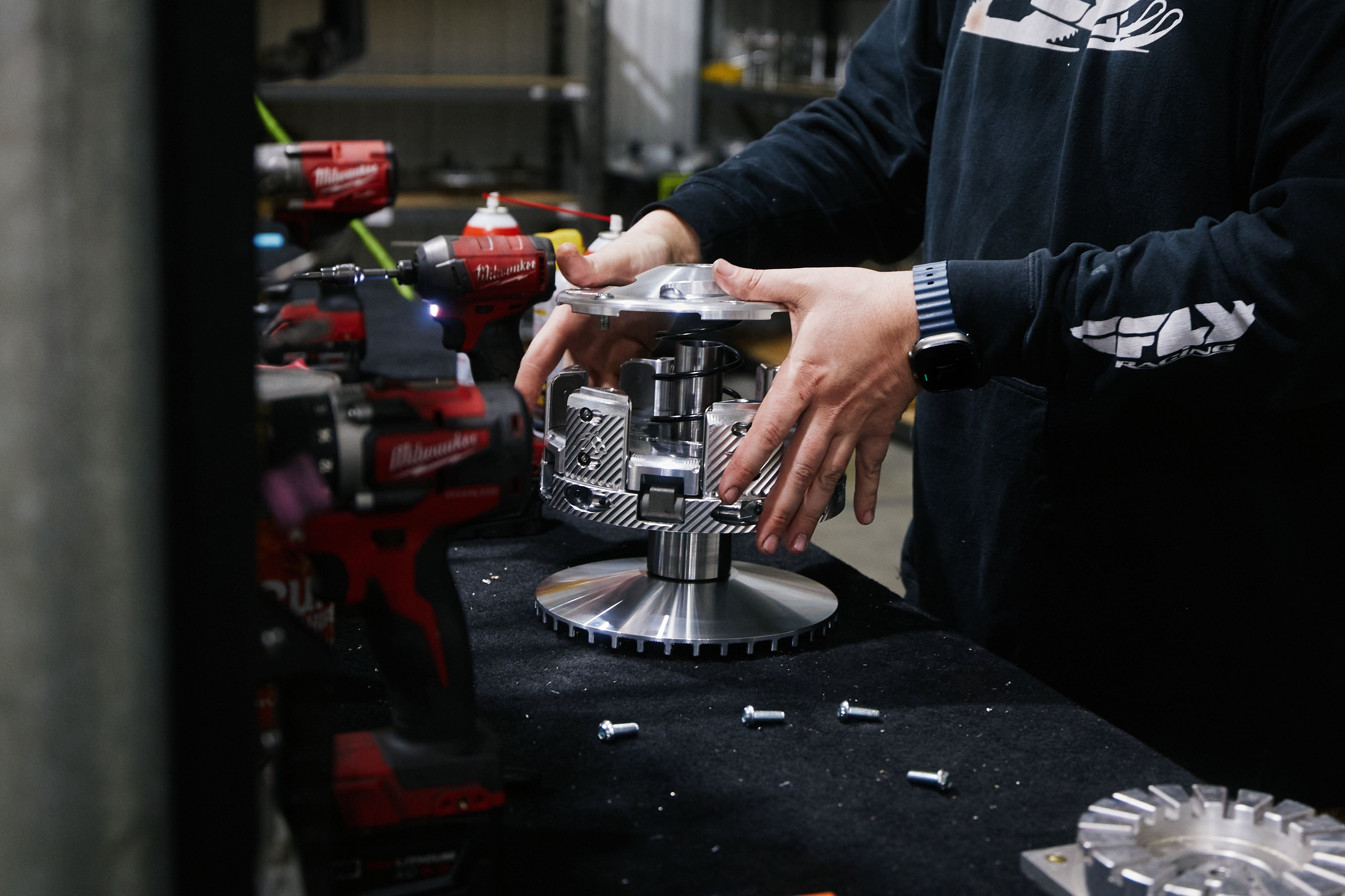What Could Cause Difficult Shifting Between Gears (P, R, N, H, L) In My X3, And How Can I Address It?
Hard shifting is almost always caused by clutch drag — the belt is spinning when it shouldn’t. Below are the most common causes and how to fix them.
⸻
1. Factory Clutch Misalignment
If the belt touches or sits too close to the primary at idle, the secondary spins and shifting becomes difficult.
Fix:
• BRP may replace the clutches under warranty
• Or send them in for the KWI Float Mod, which corrects factory alignment and keeps it adjustable
⸻
2. Primary Bearing Issues
A worn or seized primary bearing will drag the belt.
Fix: Replace the bearing.
⸻
3. Worn or Broken Secondary Rollers
Damaged rollers keep the secondary from opening/closing smoothly.
Fix: Replace the rollers (KWI Rollers recommended). Float Mod includes the upgraded rollers.
⸻
4. PDrive Primary Problems (Common on Newer Models)
• Swelling Spring Support & Stop Sleeve
Heat causes these OEM parts to swell and bind the primary, creating belt drag.
Fix: KWI’s PDrive Float Mod replaces these problem parts and eliminates the binding.
• Worn Primary Rollers (Side-to-Side Play)
As the rollers wear, they develop lateral movement. This allows the governor cup to twist, which causes the primary to stick open — a major cause of hard shifting.
Fix: Replace the rollers.
Maintenance Tip: Inspect/replace rollers every 500 miles.
⸻
5. Float Mod Install Checks
If you already have the KWI Float Mod installed, verify:
• Spring
• Billet spacer
• Shims
These must match the installation instructions exactly. Incorrect assembly can cause drag.
⸻
6. Dirty or Dry Gearbox Shaft (For Floating Secondaries)
Full Floating clutches must slide freely on the gearbox shaft. Rust, dirt, or lack of grease will make the clutch bind.
Fix:
1. Remove the secondary
2. Clean the splined shaft completely
3. Re-grease with MOLY or high-quality CV grease
4. Reinstall
⸻
Bottom Line
If shifting becomes difficult:
• Check primary roller wear (especially on PDrive)
• Check alignment
• Check for binding on the gearbox shaft
• Make sure Float Mod parts are installed correctly
Addressing these areas will restore smooth shifting and prevent belt and clutch damage.
My clutch is stuck and wont come off, how do i remove it?
If the threads in the clutch shaft are damaged but not stripped completely (the pullers are softer material than the clutch shaft). You may need to order a M14 x 1.5 extended reach tap and use it to clean up and renew the threads that are still there inside the clutch shaft. Then you will clean out the inside of the clutch shaft good with brake cleaner. Then get some soft white bread.....YES white bread.....- roll pieces of it into little logs and stuff it into the inside of the clutch shaft (make sure to leave enough room for the puller to be pushed in and catch a few threads. Then use a new clutch puller, put plenty of anti-seize on the threads and run it in to remove the clutch like normal. The bread works like hydraulic fluid to push the clutch off instead of straight mechanical force with the puller only- sounds crazy but works every time.
Why Do I Keep Breaking Belts?
There are several reasons why you might be experiencing frequent belt breakage on your vehicle.
Here are the main factors to consider:
Improper clutch calibration: Ensuring proper RPM, upshift, and avoiding belt slap on back-shifting is crucial for maintaining your belt's integrity.
Belt quality: Use a high-quality belt, as there are significant variations in strength, compound, and layup among belts. GBoost's World's Best Belt is a next-generation design that outperforms other options.
Belt and clutch cooling: Idling after hard driving does not cool the clutches or belt, and may actually damage the belt by creating localized hotspots. To properly cool the belt and clutches, drive your vehicle at 4,000-5,000 RPM for 1-2 minutes before stopping, which generates sufficient airflow for cooling.
Misalignment: Factory belt alignment issues can cause the belt to run crooked. The Full Floating Clutch Mod was developed to address this problem.
Clutch air intake: Ensure your vehicle has an unobstructed and stock clutch air intake. Modifications to the clutch air intake or factory aerodynamics, a dirty clutch air intake screen, or any accessories that obstruct airflow can increase clutch cooling air temperature, leading to belt or motor overheating. Providing cool air to the clutch and turbo air inlet is essential for preventing excessive belt temperature and failure.
By addressing these factors, you can reduce the risk of belt breakage and extend the life of your belt. Remember to perform regular maintenance and inspections to keep your vehicle running smoothly.
How Do I Maintain My Clutches? How Long Between Maintenance Intervals?
The clutches should be disassembled and serviced at the intervals described below. You can do this yourself if you have our tool kit or if you'd like you can remove the clutches and send them into us for servicing and repair and we will do it for you.
1. After every weekend or long ride (no special tools required):
Use compressed air to blow out any dirt, dust or contaminants.
Visually inspect primary and secondary clutch for any obvious damage to any components, sheave faces, etc.
Visually inspect the Belt for any clunking, fraying or abnormal wear, replace if required.
Visually inspect secondary clutch for broken helix rollers.
2. At approximately 500 miles or after a ride/race longer than 500 miles: (a KWI V2 tool kit and 500 mile service kit is required). There's a video on our website under the videos section to help with this.
Remove the KWI full floating secondary clutch, clean and re-grease the splines per the Float instructions then reinstall.
Remove the primary clutch governor cup with the KWI puller, (no need to pull the fixed sheave off the crankshaft) replace the 3 floating slider shoes, inspect the slider shoe bore for excessive wear (send clutches into KWI for repair if the bores are excessively worn) and replace the 3 floating slider shoe o-rings during reassembly
Slide off the Primary outer half, inspect thrust rollers for excessive wear or damage, replace if damaged.
Remove the primary bearing, clean, re-grease with a light amount of Kluber Isoflex NB52. wipe seals so they are free of grease and dry before reinstalling.
Clean primary bearing thrust washers so they are completely free of grease and dry. Replace if worn.
Why Am I Getting Misfire Codes After Installing The PDrive Clutch On My Can-Am X3 UTV?
ssue: On some Polaris and Can-Am models, installing a different primary clutch like the PDrive can trigger a misfire fault code. This happens because the vehicle's ECU is calibrated to the vibration frequency of the original clutch. The new clutch, although functioning normally, might have a different vibration signature that exceeds the ECU's knock threshold limits, leading to these fault codes.
Solution: If these codes appear after changing the primary clutch, you might need a tune update. For modified vehicles, get the latest tune files from tuners like Whalen Speed, EVO, AA, DynoJet, etc., which account for this change. For stock vehicles, have your dealer update the ECU with the latest software. Note: These codes could also indicate an actual misfire due to issues like a bad oxygen sensor or faulty spark plugs.
Have more questions?
Hit our full Support Portal for more FAQs, guides, and troubleshooting.

